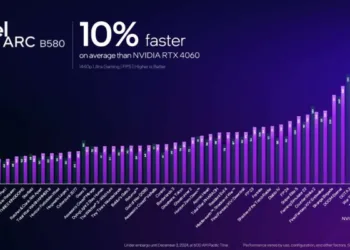Intel is reportedly poised to launch its 15th-generation Arrow Lake processors in just a few weeks. This new series is anticipated to position itself among the top contenders in the CPU market, employing the newly designed LGA 1851 socket. However, this new packaging might present challenges in managing thermal performance effectively.
Well-known overclocker and YouTuber der8auer has pointed out that the hottest point of the Arrow Lake CPUs is located “much further north,” indicating that the peak thermal area is found near the top of the chip. While varying hot spot locations are not uncommon—AMD’s Ryzen 9 9950X, for example, has its hot spot toward the bottom of the package—this change means that cooling solutions will need to adapt to optimize performance.
Compatibility also becomes a topic of discussion here. Although reports suggest the LGA 1851 socket matches the dimensions of the LGA 1700 socket, implying that most existing CPU coolers should remain compatible with the new socket, some upgrades to mounting hardware may be necessary. Previous Intel CPUs featured a monolithic design, centering the hot spot near the chip’s center. In contrast, Arrow Lake employs a structure that combines different dies, similar to AMD’s newer Ryzen CPUs, leading to a repositioning of the compute tile—now located closer to the top of the package.
The question now is whether this shift will significantly impact cooling performance for current coolers. The integrated heat spreader (IHS), CPU mount block, and thermal paste all collaborate to ensure optimal heat dissipation between the CPU and cooler. However, der8auer notes that “to achieve optimal cooling, the center of cooling should be adjusted to target the hot spot. Rotating the cooler’s block 180 degrees could negatively affect thermal performance.”
For overclockers aiming to extract maximum performance from their setups, the relocation of the hot spot will matter. Der8auer suggests that a custom water block with the inlet positioned at the north end of the chip and the outlet at the south would offer the best cooling solution. Meanwhile, typical users may not notice a substantial difference in performance, as this largely depends on the heat output of the CPU itself.
Intel’s latest high-performance CPUs, like the Core i9-14900K and Core i9-13900K, are known to demand considerable cooling capabilities. Even with a high-quality all-in-one (AIO) liquid cooler, the latest flagship scores temperatures reaching 90 degrees Celsius or more under heavy workloads. Should the Arrow Lake series have similar thermal requirements, then the positioning of your CPU cooler could indeed play a crucial role in performance—especially when every degree counts between optimal performance and thermal throttling.
We can expect to learn more about the Arrow Lake CPUs soon, as rumors suggest that Intel may unveil the new lineup on October 10, followed by a release later that month.









